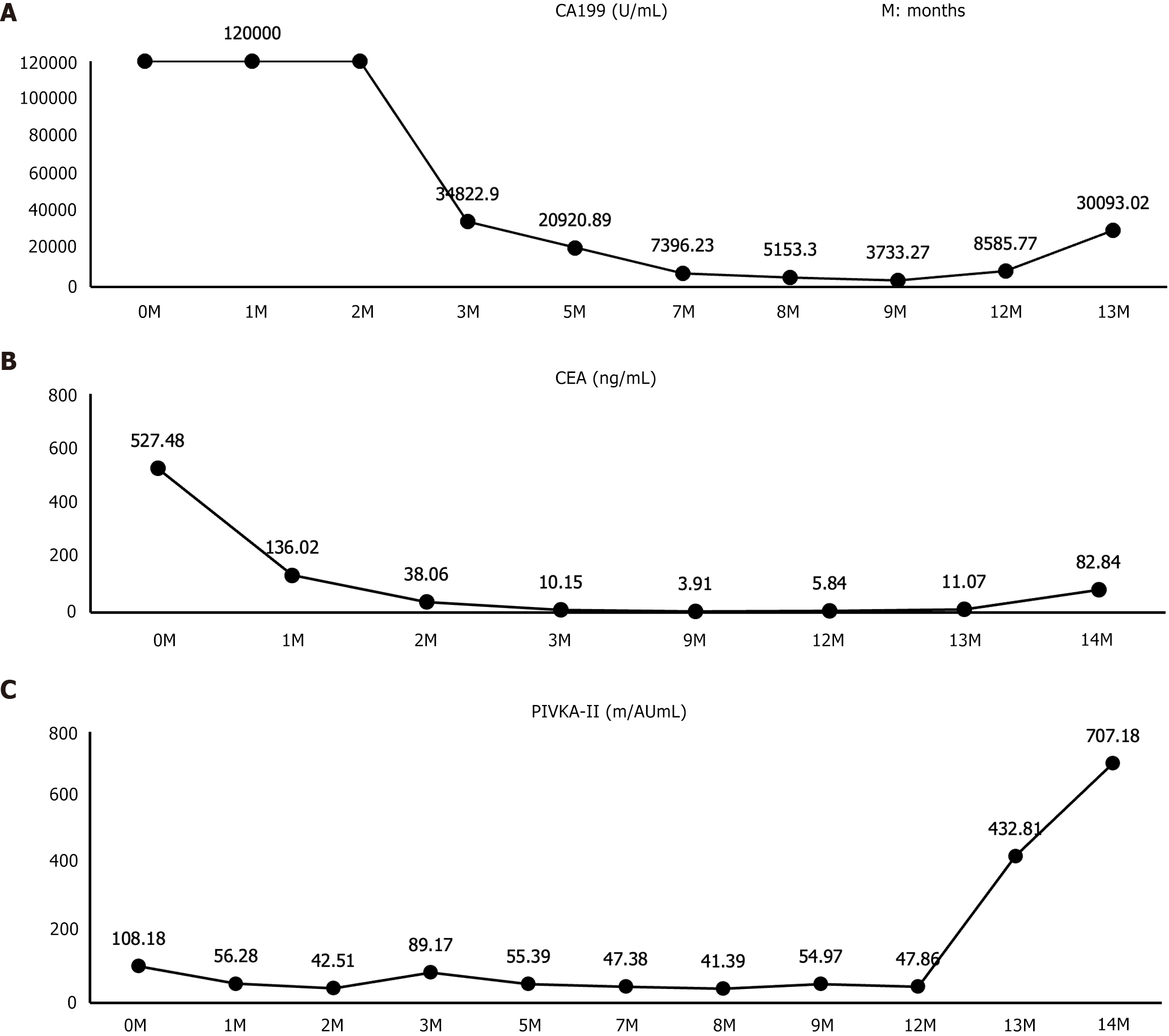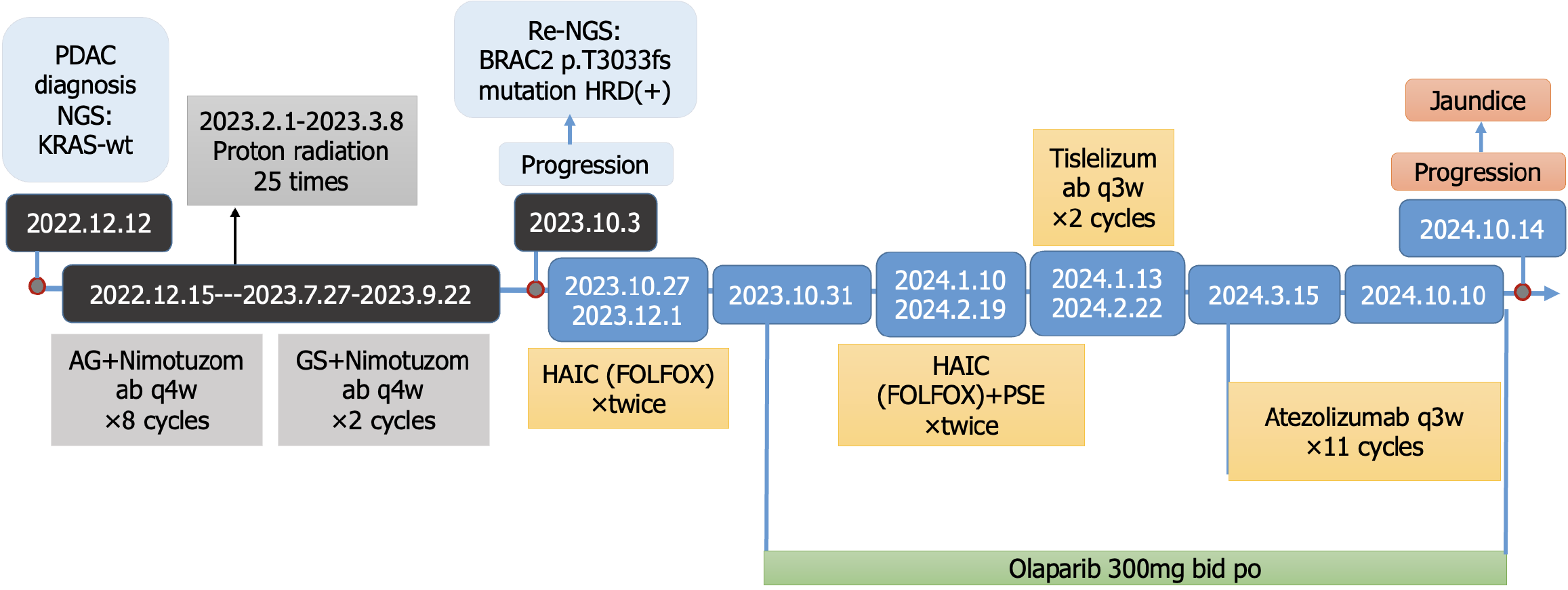Copyright
©The Author(s) 2025.
World J Hepatol. Jul 27, 2025; 17(7): 106993
Published online Jul 27, 2025. doi: 10.4254/wjh.v17.i7.106993
Published online Jul 27, 2025. doi: 10.4254/wjh.v17.i7.106993
Figure 1 Contrast-enhanced abdominal magnetic resonance imaging findings of hepatic metastases before and during systemic therapy.
A: The baseline imaging demonstrates multiple heterogeneously enhancing hepatic metastases (the arrow indicates a confluent tumor mass); B: After treatment for 7 months, the number and size of the metastatic lesions decreased. The arrow-indicated confluent tumor mass is markedly reduced in size; C: After treatment for 9 months, the lesions further improved (indicated with arrow).
Figure 2 Alterations in serum tumor biomarker levels (carbohydrate antigen 19-9, carcinoembryonic antigen, and protein induced by vitamin K absence II) over the course of treatment.
A: Carbohydrate antigen 19-9 levels demonstrate a significant therapeutic response with at least 71% reduction from baseline by month 3 (> 120000 U/mL to 34822.9 U/mL), followed by a marked increase beginning at month 12 (8585.77 U/mL; normal range < 37 U/mL); B: The carcinoembryonic antigen level showed a steep decrease spanning month 1 (declining from 527.48 ng/mL to 136.02 ng/mL), at month 13, it began to increase (11.07 ng/mL; normal range ≤ 5 ng/mL); C: The protein induced by vitamin K absence II level exhibited an initial response (baseline 10818 mAU/mL to 56.28 mAU/mL at month 1) preceding a marked rise to 432.81 mAU/mL at month 13 (normal range < 40 mAU/mL). CA199: Carbohydrate antigen 199; CEA: Carcinoembryonic antigen; PIVKA-II: Protein induced by vitamin K absence II.
Figure 3 The overall treatment process of the case.
The patient was diagnosed with Pancreatic ductal adenocarcinoma, and next-generation sequencing on December 12, 2022, revealed wild-type KRAS. Subsequently, the patient was treated with gemcitabine + albumin-bound paclitaxel + nimotuzomab q4w × 8 cycles, proton radiation 25 times and gemcitabine + tegafur/gimeracil/oteracil potassium + nimotuzomab q4w × 2 sequential cycles. The tumor progressed on October 3, 2023. The patient was then visit our molecular tumor boards clinic. Repeat next-generation sequencing identified homologous recombination deficiency positivity and a pathogenic BRCA2 mutation, prompting the initiation of hepatic arterial infusion chemotherapy (5-fluorouracil + leucovorin + oxaliplatin) + immune checkpoint inhibitors + olaparib. On October 14, 2024, jaundice was observed, with a subsequent confirmation of disease progression. PDAC: Pancreatic ductal adenocarcinoma; NGS: Next-generation sequencing; AG: Gemcitabine + albumin-bound paclitaxel; GS: Gemcitabine + tegafur/gimeracil/oteracil potassium; HRD: Homologous recombination deficiency HAIC: Hepatic arterial infusion chemotherapy; FOLFOX: 5-fluorouracil + leucovorin + oxaliplatin; PSE: Partial splenic embolization.
- Citation: Yan Y, Ren ZZ, Wang WY, Tang J, Zhang YW. Molecular tumor boards in pancreatic cancer with liver metastasis: A case report. World J Hepatol 2025; 17(7): 106993
- URL: https://www.wjgnet.com/1948-5182/full/v17/i7/106993.htm
- DOI: https://dx.doi.org/10.4254/wjh.v17.i7.106993











